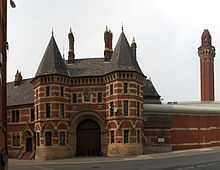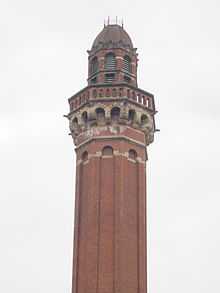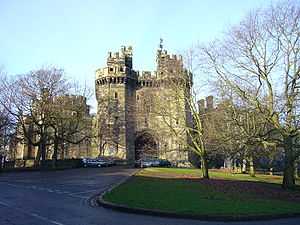HM Prison Manchester
 | |
| Location | Strangeways, Manchester |
|---|---|
| Security class | Adult Male/Category A |
| Population | 1269 (as of August 2008) |
| Opened | 1868 |
| Managed by | HM Prison Services |
| Governor | Hannah Lane |
| Website | Manchester at justice.gov.uk |
HM Prison Manchester is a high-security male prison in Manchester, England operated by Her Majesty's Prison Service. It is a local prison, holding prisoners remanded into custody from courts in the Manchester area and Category A prisoners.
HM Prison Manchester was known as Strangeways, after the area in which it is located, until it was rebuilt following a major riot in 1990.
History

Construction of the Grade II listed prison was completed in 1869, and it was opened on 25 June 1868, to replace the New Bailey Prison in Salford, which closed in 1868. The prison, designed by Alfred Waterhouse in 1862 with input from Joshua Jebb,[1] cost £170,000, and had a capacity of 1,000 inmates. Its 234 feet (71 m) ventilation tower (often mistaken for a watchtower) has become a local landmark.[2] The prison's walls, which are rumoured to be 16 feet thick, are said to be impenetrable either from inside or out.
The prison has an element of the panopticon with its plan in the form of a star or a snowflake, with two blocks housing ten wings that emanate from a central core where the watchtower is situated.[3] The prison consists of two radial blocks branching from the central core with a total of ten wings (A, B, C, D, E, F in one block, and G, H, I, K in the second).[4]
The gaol was built on the grounds of Strangeways Park and Gardens, from which it was named. Strangeways was recorded in 1322 as Strangwas from the Anglo-Saxon Strang and gewæsc meaning "[a place by] a stream with a strong current".
The prison was open to male and female prisoners until 1963 when the facility became male-only, and in 1980 it began to accept remand prisoners. As of 2005 the prison held more than 1,200 inmates.
As a place of execution

Originally, the prison contained an execution shed in B wing and after World War I a special execution room and cell for the condemned criminal was built. Strangeways was one of the few prisons to have permanent gallows.[2] The first execution at Strangeways was that of twenty-year-old murderer Michael Johnson who was hanged by William Calcraft on 29 March 1869.[5]
Twenty-nine hangings took place over the next twenty years and 71 took place in the 20th century, bringing the total number to 100. During the second half of the century, the number of executions decreased, with no hangings between 1954 and 28 November 1962, when James Smith was executed. John Robson Walby (alias Gwynne Owen Evans), one of the last two people to be hanged in England, was executed here on 13 August 1964. Out of the 100 hangings, four were double hangings, while the rest were done individually. The "quickest hanging" of James Inglis in seven seconds, carried out by Albert Pierrepoint, took place here.[6]
Other executions
Mary Ann Britland (38) was executed on 9 August 1886 for the murder of two family members and her neighbour. She was the first woman to be executed at the prison. John Jackson was executed on 7 August 1879. Thom Davies was hanged on 9 January 1889 for sexual deviancy charges. Lieutenant Frederick Rothwell Holt was hanged on 13 April 1920 for the murder of twenty-six-year-old Kathleen Breaks. Louie Calvert was hanged on 24 June 1926.[2]
Doctor Buck Ruxton was executed on 12 May 1936 for the murder of his wife. A petition for clemency was signed by 10,000 people, both sympathetic locals with high regard for this "people's doctor" and abolitionists who mounted a large demonstration on the day of his execution. Margaret Allen was hanged on 12 January 1949 by Albert Pierrepoint for the murder of an elderly widower. Her execution was the first of a woman in Britain for twelve years.[2] and the third execution of a woman at Strangeways.
After the seven second hanging, Albert Pierrepoint executed Louisa May Merrifield on 18 September 1953. She was the fourth and last woman to be executed at the prison.[7][8]
The bodies of executed criminals were buried in unmarked graves within the prison walls, as was the custom. During prison rebuilding work in 1991, the remains of 63 executed prisoners (of which 45 were identifiable) were exhumed from unmarked graves in the prison cemetery[9] and cremated at Blackley Crematorium in Manchester. The cremated remains were re-interred in two graves (plot C2710 and C2711) at the adjacent cemetery.[10][11]
Strangeways riots
Between 1 April and 25 April 1990, 147 staff and 47 prisoners were injured in a series of riots by prison inmates. There was one fatality among the prisoners, and one prison officer died from heart failure.[12] Much of the old prison was damaged or destroyed in the rioting. Several inmates were charged with various offences, and Paul Taylor and Alan Lord faced a five-month trial as ringleaders.
The riots resulted in the Woolf Inquiry, and the prison was rebuilt and renamed Her Majesty's Prison, Manchester. Repair and modernisation cost more than £80 million after the riot, and rebuilding was completed in 1994.[13]
The prison today
The prison is a high-security category A prison for adult males and has a maximum capacity of 1269 as of 4 August 2008. Operation of the prison was put out to tender in 1994 and 2001.[4] Accommodation is divided into nine wings in two radial blocks. Cells are a mixture of single and double occupancy, all having in-cell power points and integral sanitation.
The prison has been noted for a high suicide rate following its reopening in 1994. From 1993 to 2003, Strangeways prison had the highest number of suicides among inmates than any other prison in the United Kingdom[14] and 2004, Strangeways had the highest number of suicides in the country.[15]
Education and vocational training is provided by the Manchester College. Courses offered include information technology, ESOL, numeracy, industrial cleaning, bricklaying, painting and decorating, plastering, textiles and laundry. The prison's gym runs courses in physical education and offers recreational sport and fitness programmes.
Notable inmates
- Joey Barton, footballer gaoled for assault.[16]
- Brendan Behan, Irish republican, playwright and poet, imprisoned in Strangeways in 1947 for attempting to free a IRA prisoner.[17]
- Ian Brady, held for theft prior to the Moors murders.
- Mark Bridger, held there on remand and now serving a life sentence for the murder and abduction of April Jones.
- Ian Brown, rock singer gaoled for "air rage", released in December 1999.[18]
- Dale Cregan, held there on remand whilst awaiting trial for the murders of Mark Short, David Short, Nicola Hughes and Fiona Bone. He is also accused of the attempted murders of Michael Belcher, Ryan Pridding John Short and Sharon Hark.[19]
- Emily Davison, Suffragette, sentenced to a month's hard labour in 1909 after throwing rocks at the carriage of chancellor David Lloyd George. Hunger strike led to force feeding. Blockaded herself in her cell and sued Strangeways for using a water cannon.
- David Dickinson, TV presenter specialising in antiques, imprisoned for fraud in pre-celebrity days.[20]
- James Inglis, the world's fastest hanging.[6]
- Sean Mercer, held there during his trial at Liverpool Crown Court, for the murder of Rhys Jones.
- Christabel Pankhurst, suffragette, was held for a week.[1]
- Gordon Park was convicted in 2005 of murdering his first wife, Carol Park, in 1976.[21]
- Harold Shipman, held there on remand whilst awaiting trial.
Cultural references
- "Strangeways", a track on the 1987 rock album The House of Blue Light by Deep Purple
- Strangeways, Here We Come, 1987 rock album by The Smiths.
- 'Mad' Frankie Fraser (1982) was held on 'A' Wing and excused boots for supposed fallen arches.
- Eric Allison (1970) went on to be The Guardian Prison Reporter and author of A Serious Disturbance, an account of the Strangeways Riot. A chapter of Eric's book was written by former Strangeways Hospital Officer John G. Sutton.
- In the song "There Goes a Tenner" from the album The Dreaming, Kate Bush sings of being "a star in Strangeways". The song is about a botched bank robbery.
- The song "Fallowfield Hillbilly", from the album St. Jude by Manchester band The Courteeners, refers to Strangeways and the type of people that "indie snobs" perceive to be its inmates.
- In the comic Hellblazer, issue 34 (October 1990), the main character John Constantine refers to Strangeways prison "exploding with [excrement] and blood," and describes its holding cells as "Victorian pressure cookers" into which government officials who turn a blind eye should be squeezed to "see what pops out of [their] pimple."
- In the TV series Shameless, Frank Gallagher often refers to his time in Strangeways.
- In the TV series Beautiful People, Debbie Doonan, who dislikes the police, shouts to an officer "them blokes from Strangeways had the right idea," a reference to the Strangeways Prison riot.
- Graham Fellows, in his comedic persona of John Shuttleworth, wrote a song that began, "You're like Manchester, you've got strange ways".
- "Strangeways Hotel", a song by Mike Harding.
- In the book Pollen by Mancunian author Jeff Noon two of the central characters visit Strangeways in order to speak to a prisoner. The prison has become a "Virtual" (sic) prison, where the inmates are kept locked in drawers on large amounts of a psychoactive drug that puts them into a permanent, pleasant dreamlike state.
- Strangeways was the name of the "prison cat" in the 1960 movie Two-Way Stretch, a comedy set inside a fictitious Manchester Prison which starred Peter Sellers, Lionel Jefferies and Wilfrid Hyde-White.
- Strangeways' Screw is a track from the album 'Seriously Disturbed' by 2hatJohn'.
References
- Notes
- ↑ 1.0 1.1 "Strangeways Prison, Manchester". Manchester 2002 UK. Retrieved 11 July 2010.
- ↑ 2.0 2.1 2.2 2.3 "Strangeways Prison". Capital Punishment U.K. Retrieved 8 July 2010.
- ↑ Miller, Keith (14 June 2003). "Making the grade: Strangeways". Daily Telegraph (London). Retrieved 26 June 2011.
- ↑ 4.0 4.1 "Manchester". Her Majesty's Prison Service. Archived from the original on May 5, 2011. Retrieved 11 July 2010.
- ↑ Fielding 1994, p. 7
- ↑ 6.0 6.1 Fielding 2008, pp. 239–240
- ↑ Eddleston 2004, p. 839
- ↑ http://www.stephen-stratford.co.uk/merrifield.htm
- ↑ "Mass Exhumation". Cherished Land. Retrieved 11 July 2010.
- ↑ "Consistory Court Cases 2007" (PDF). Ecclesiastical Law Society. Retrieved 11 July 2010.
- ↑ http://www.manchester-family-history-research.co.uk/new_page_26.htm
- ↑ "On This Day: 1 April". BBC News. 1 April 1990. Retrieved 2007-05-05.
- ↑ de Leng, Stephanie (12 May 2011). "Life in Strangeways". Liverpool Confidential. Retrieved 26 June 2011.
- ↑ "Shock suicide toll at Strangeways". Manchester Evening News. 29 January 2003. Retrieved 26 June 2011.
- ↑ "Prison suicide record condemned". BBC News. 8 February 2005. Retrieved 26 June 2011.
- ↑ "Joey Barton released from prison". BBC News. 28 July 2008. Retrieved 26 May 2011.
- ↑ Letters of Brendan Behan, McGill-Queen's University Press 1992, p. 48
- ↑ "Articles". Dave Haslam. Retrieved 8 July 2010.
- ↑ Martin Robinson. "Cregan remanded in custody". Daily Mail. Retrieved 21 September 2012.
- ↑ "The Official David Dickinson Website". Retrieved 11 July 2010.
- ↑ "Vigil for Lady in the Lake killer". BBC News. 28 January 2006. Retrieved 11 July 2010.
- Bibliography
- Eddleston, John J. (2004). The Encyclopaedia of Executions. London: John Blake Publishing Ltd. ISBN 1-84454-058-8.
- Fielding, Steve (1994). The Hangman's Record. Volume One: 1868–1899. Beckenham: Chancery House Press. ISBN 0-900246-65-0.
- Fielding, Steve (2008). Pierrepoint: A Family of Executioners. London: John Blake Publishing Ltd. ISBN 978-1-84454-611-4.
External links
| Wikimedia Commons has media related to Manchester (HM Prison). |
- Capital Punishments Executed at Strangeways, Manchester in the 20th Century
- Ministry of Justice pages on Manchester
Coordinates: 53°29′33″N 2°14′47″W / 53.49250°N 2.24639°W
| ||||||||||





